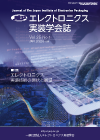Volume 25, Issue 3
Displaying 1-22 of 22 articles from this issue
- |<
- <
- 1
- >
- >|
Preface
-
Article type: Preface
2022Volume 25Issue 3 Pages P3
Published: May 01, 2022
Released on J-STAGE: May 01, 2022
Download PDF (182K)
Special Articles / Printed Circuit Board Technology for the Electronic Equipment in Society 5.0
-
Article type: Special Articles
2022Volume 25Issue 3 Pages 185
Published: May 01, 2022
Released on J-STAGE: May 01, 2022
Download PDF (307K) -
Article type: Special Articles
2022Volume 25Issue 3 Pages 186-190
Published: May 01, 2022
Released on J-STAGE: May 01, 2022
Download PDF (1228K) -
Article type: Special Articles
2022Volume 25Issue 3 Pages 191-195
Published: May 01, 2022
Released on J-STAGE: May 01, 2022
Download PDF (1309K) -
Article type: Special Articles
2022Volume 25Issue 3 Pages 196-203
Published: May 01, 2022
Released on J-STAGE: May 01, 2022
Download PDF (1249K) -
Article type: Special Articles
2022Volume 25Issue 3 Pages 204-209
Published: May 01, 2022
Released on J-STAGE: May 01, 2022
Download PDF (908K)
Technical Paper
-
Article type: Technical Paper
2022Volume 25Issue 3 Pages 210-217
Published: May 01, 2022
Released on J-STAGE: May 01, 2022
Advance online publication: December 30, 2021Download PDF (1652K) -
Article type: Technical Paper
2022Volume 25Issue 3 Pages 218-224
Published: May 01, 2022
Released on J-STAGE: May 01, 2022
Advance online publication: February 02, 2022Download PDF (1381K) -
Article type: Technical Paper
2022Volume 25Issue 3 Pages 225-231
Published: May 01, 2022
Released on J-STAGE: May 01, 2022
Advance online publication: February 02, 2022Download PDF (1165K) -
Article type: Technical Paper
2022Volume 25Issue 3 Pages 232-239
Published: May 01, 2022
Released on J-STAGE: May 01, 2022
Advance online publication: February 18, 2022Download PDF (2740K) -
Article type: Technical Paper
2022Volume 25Issue 3 Pages 240-249
Published: May 01, 2022
Released on J-STAGE: May 01, 2022
Advance online publication: March 09, 2022Download PDF (1343K) -
Article type: Technical Paper
2022Volume 25Issue 3 Pages 250-259
Published: May 01, 2022
Released on J-STAGE: May 01, 2022
Advance online publication: March 23, 2022Download PDF (1408K) -
Article type: Technical Paper
2022Volume 25Issue 3 Pages 260-268
Published: May 01, 2022
Released on J-STAGE: May 01, 2022
Advance online publication: March 23, 2022Download PDF (1538K)
Short Note
-
Article type: Short Note
2022Volume 25Issue 3 Pages 269-271
Published: May 01, 2022
Released on J-STAGE: May 01, 2022
Advance online publication: January 14, 2022Download PDF (565K)
Report
-
Article type: Report
2022Volume 25Issue 3 Pages 272
Published: May 01, 2022
Released on J-STAGE: May 01, 2022
Download PDF (315K)
Announcement, Contents, etc.
-
Article type: Announcement
2022Volume 25Issue 3 Pages 273
Published: May 01, 2022
Released on J-STAGE: May 01, 2022
Download PDF (331K) -
Article type: Announcement
2022Volume 25Issue 3 Pages 274
Published: May 01, 2022
Released on J-STAGE: May 01, 2022
Download PDF (190K) -
Article type: Announcement
2022Volume 25Issue 3 Pages 275-276
Published: May 01, 2022
Released on J-STAGE: May 01, 2022
Download PDF (422K) -
Article type: Announcement
2022Volume 25Issue 3 Pages A31-
Published: May 01, 2022
Released on J-STAGE: May 01, 2022
Download PDF (548K) -
Article type: Announcement
2022Volume 25Issue 3 Pages C31
Published: May 01, 2022
Released on J-STAGE: May 01, 2022
Download PDF (590K) -
Article type: Announcement
2022Volume 25Issue 3 Pages C32
Published: May 01, 2022
Released on J-STAGE: May 01, 2022
Download PDF (491K) -
Article type: Announcement
2022Volume 25Issue 3 Pages I31-
Published: May 01, 2022
Released on J-STAGE: May 01, 2022
Download PDF (511K)
- |<
- <
- 1
- >
- >|
